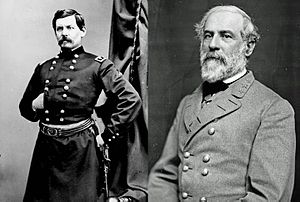
Back یئدی گۆن ساواشلاری AZB Batalles dels Set Dies Catalan Battaglia di i Sette Ghjorni Corsican Syvdagesslaget Danish Sieben-Tage-Schlacht German Batallas de los Siete Días Spanish جنگهای هفت روزه Persian Bataille des Sept Jours French קרבות שבעת הימים HE Sedmodnevna bitka Croatian
| Seven Days Battles | |||||||
|---|---|---|---|---|---|---|---|
| Part of the American Civil War | |||||||
 George B. McClellan and Robert E. Lee, respective commanders of the Union and Confederate armies in the Seven Days | |||||||
| |||||||
| Belligerents | |||||||
|
|
| ||||||
| Commanders and leaders | |||||||
|
|
| ||||||
| Units involved | |||||||
|
|
| ||||||
| Strength | |||||||
|
101,434 ("present for duty"):[2][3]
| 112,200 "present for duty"[4] | ||||||
| Casualties and losses | |||||||
|
15,855 1,734 killed 8,066 wounded 6,055 missing/captured[5][6] |
20,204 3,494 killed 15,758 wounded 952 missing/captured[7] | ||||||
The Seven Days Battles were a series of seven battles over seven days from June 25 to July 1, 1862, near Richmond, Virginia, during the American Civil War. Confederate General Robert E. Lee drove the invading Union Army of the Potomac, commanded by Maj. Gen. George B. McClellan, away from Richmond and into a retreat down the Virginia Peninsula. The series of battles is sometimes known erroneously as the Seven Days Campaign, but it was actually the culmination of the Peninsula Campaign, not a separate campaign in its own right.
The Seven Days began on Wednesday, June 25, 1862, with a Union attack in the minor Battle of Oak Grove, but McClellan quickly lost the initiative as Lee began a series of attacks at Beaver Dam Creek (Mechanicsville) on June 26, Gaines's Mill on June 27, the minor actions at Garnett's and Golding's Farm on June 27 and 28, and the attack on the Union rear guard at Savage's Station on June 29. McClellan's Army of the Potomac continued its retreat toward the safety of Harrison's Landing on the James River. Lee's final opportunity to intercept the Union Army was at the Battle of Glendale on June 30, but poorly executed orders and the delay of Stonewall Jackson's troops allowed his enemy to escape to a strong defensive position on Malvern Hill. At the Battle of Malvern Hill on July 1, Lee launched futile frontal assaults and suffered heavy casualties in the face of strong infantry and artillery defenses.
The Seven Days ended with McClellan's army in relative safety next to the James River, having suffered almost 16,000 casualties during the retreat. Lee's army, which had been on the offensive during the Seven Days, lost over 20,000. As Lee became convinced that McClellan would not resume his threat against Richmond, he moved north for the northern Virginia campaign and the Maryland campaign.
- ^ McPherson, Battle Cry of Freedom, p.470
- ^ Further information: Official Records, Series I, Volume XI, Part 3, page 238.
- ^ 104,100 according to Sears, Gates of Richmond, p. 195: "on June 26, Porter's corps had 28,100; south of the Chickahominy River, the other four corps had 76,000." Rafuse, p. 221, cites 101,434 Union present for duty.
- ^ Sears, Gates of Richmond, p. 195: "on June 26, Magruder and Huger had 28,900 south of the Chickahominy; Longstreet, A.P. Hill, D.H. Hill, Jackson, and part of Stuart's cavalry brigade, 55,800; Holmes in reserve, 7,300." Rafuse, p. 221, cites 112,220 Confederate present for duty after the arrival of Jackson's command.
- ^ Further information: Official Records, Series I, Volume XI, Part 2, pages 21-37
- ^ 15,855
1,734 killed
8,066 wounded
6,055 missing/captured according to Sears, Gates of Richmond, p. 345. - ^ Further information: Official Records, Series I, Volume XI, Part 2, pages 502-510 and pages 973-984
- ^ 20,204 total (3,494 killed; 15,758 wounded; 952 missing/captured) according to Sears, Gates of Richmond, p. 343.
© MMXXIII Rich X Search. We shall prevail. All rights reserved. Rich X Search